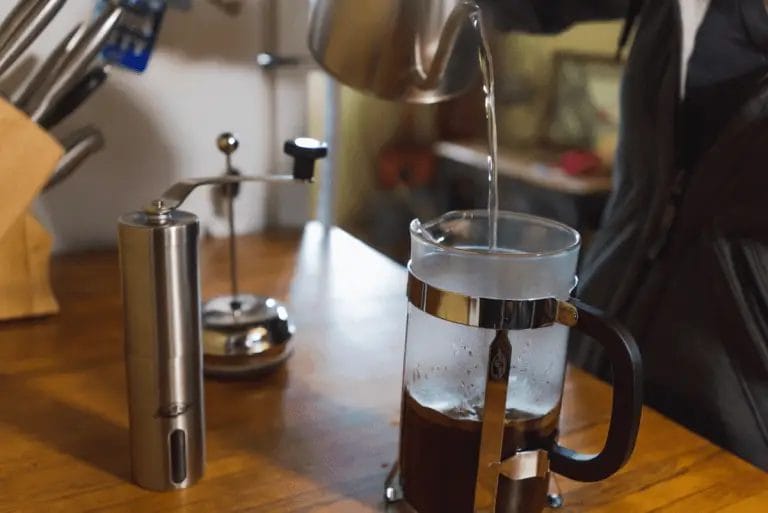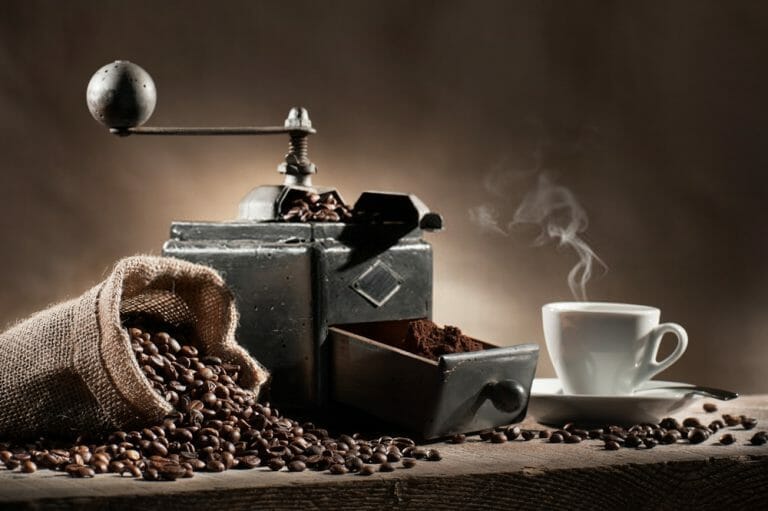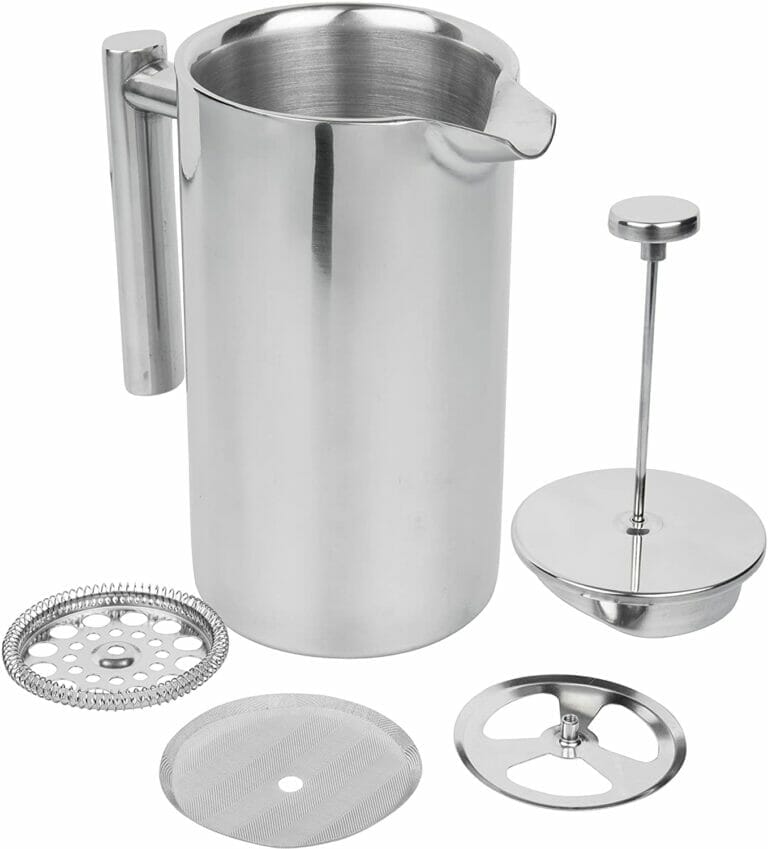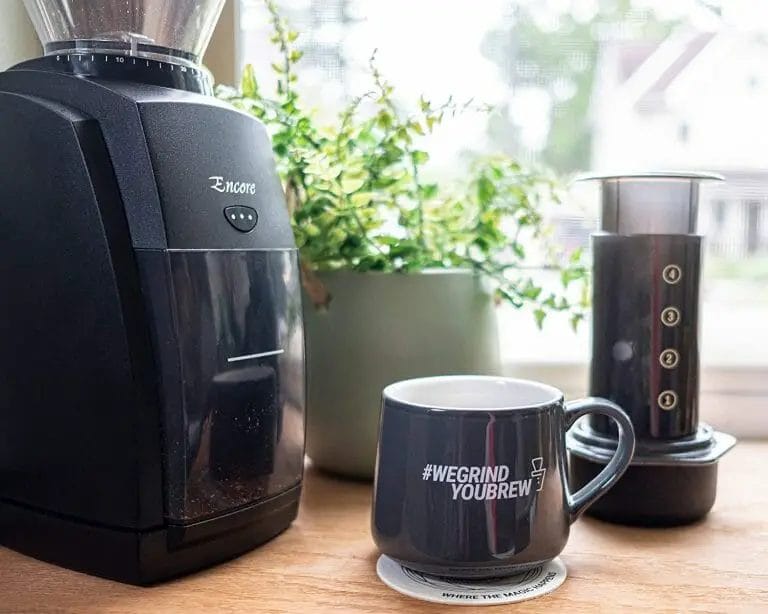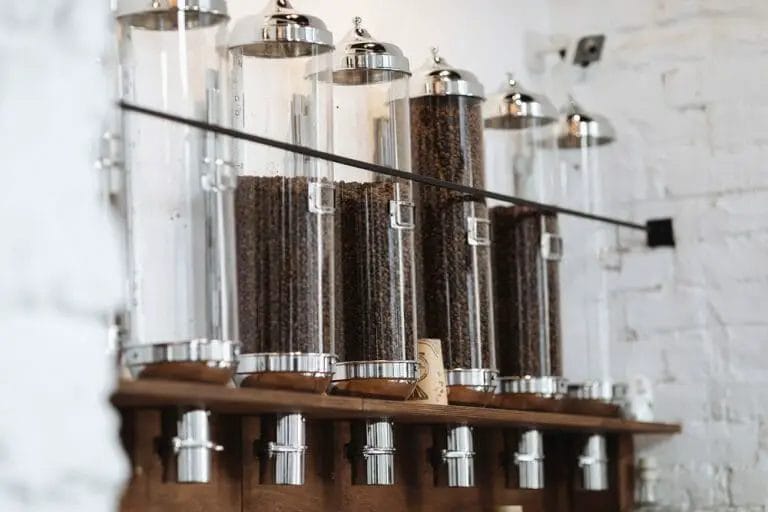How To Grind Coffee Beans For French Press?
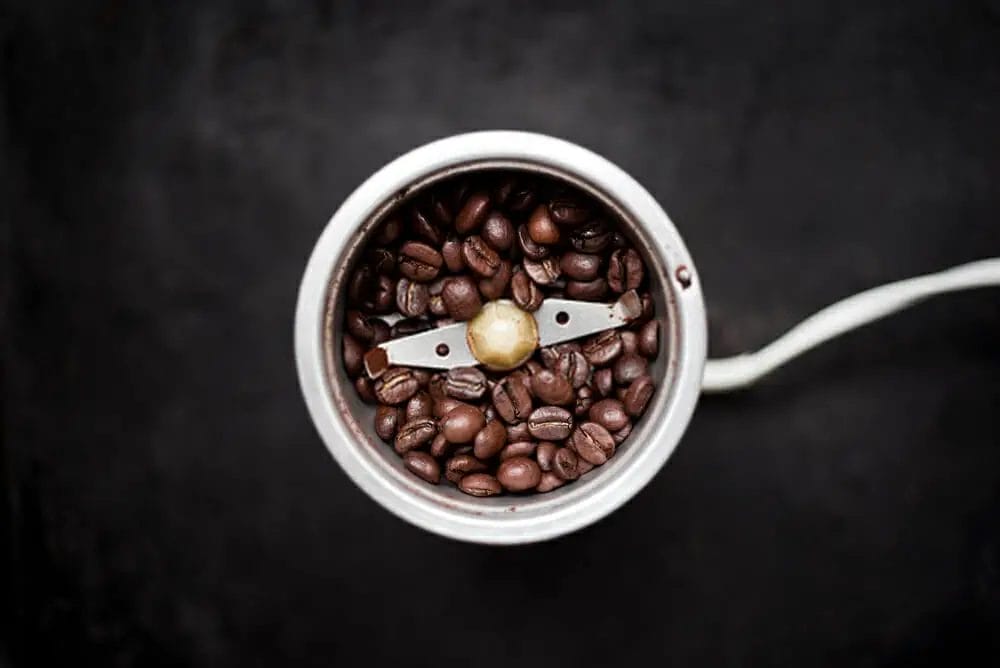
I have always been a coffee lover, and one of my favorite ways to brew coffee is through the French press method.
However, I quickly learned that the key to a perfect cup of French press coffee lies in the grind setting.
Getting it right can be tricky and requires attention to detail, but once you master it, you’ll never go back to pre-ground coffee again.
In this article, I will guide you through the process of grinding coffee beans for French press using a step-by-step approach. We’ll start by understanding why grind setting is important for French press brewing and how it affects the taste of your coffee.
Then we’ll dive into finding the right grind setting based on your personal preferences and equipment. So let’s grab our grinders and get started!
Key Takeaways
- Grind Settings: Critical to extraction time and flavor profile of the coffee.
- Coarse Grind: Recommended for French press coffee, such as setting 28 on a Baratza Encore.
- Micron Level: Precise measurement is not necessary, focus on coarse grind.
- Extraction Time: Four minutes is ideal for steeping coffee in a French press.
- Taste Assessment: Adjust grind setting and brew again if coffee is too bitter or too weak.
- Steak Analogy: Different grind settings, like steak thicknesses, require different extraction times.
- Experimentation: Test various grind settings and brewing techniques to enhance your experience.
- Attention to Detail: Needed for exploring and achieving a rich, flavorful French press coffee.
Importance of grind setting for French press coffee

You’ll want to pay attention to the grind setting if you’re looking for a rich and full-bodied French press coffee experience!
The grind size plays a crucial role in determining how your coffee will taste.
When using a French press, it’s important to use a coarse grind setting as this allows for a slower extraction process that brings out the natural flavors and oils of the coffee beans.
If your grind is too fine, it can result in over-extraction, leading to bitter and unpleasant tasting coffee.
It’s also important to note that different types of beans require different grinds, so experiment with different settings until you find what works best for you.
Remember, grinding your own beans right before brewing ensures maximum freshness and flavor, giving you the ultimate control over your cup of coffee!
Finding the Right Grind Setting
When it comes to French press coffee, the right grind setting can make all the difference.
Understanding the relationship between grind setting, extraction time, and flavor profile is key to achieving a perfect cup of coffee.
To help you get started, I recommend a coarse grind setting of around 28 on a Baratza Encore grinder.
However, it’s important to remember that different grinders may require some adaptation in order to achieve the desired result.
Understanding the relationship between grind setting, extraction time, and flavor profile
So, if you want to get the perfect flavor profile for your French press coffee, it’s important to understand how the grind setting and extraction time are related.
The finer the grind setting, the more quickly water will extract flavors from the coffee beans.
Conversely, a coarser grind setting will result in a slower extraction time. This relationship is crucial because it impacts the overall taste of your coffee.
To help you visualize this relationship, I’ve created a table below that showcases how different grind settings and extraction times can affect flavor profiles.
Keep in mind that these are general guidelines and may vary depending on your specific French press and personal preferences.
| Grind Setting | Extraction Time | Flavor Profile |
|---|---|---|
| Coarse | 4 minutes | Light-bodied |
| Medium-coarse | 3-4 minutes | Balanced |
| Medium | 2-3 minutes | Rich |
| Medium-fine | 1-2 minutes | Bold |
| Fine | <1 minute | Intense |
As you can see from the table above, adjusting either the grind size or brewing time can greatly impact your end result.
So take some time to experiment with different combinations until you find what works best for you.
Remember that ultimately there are no set rules when it comes to making coffee – it’s all about finding what tastes good to you and gives you that sense of freedom in starting your day off right.
Recommended coarse grind setting (e.g., 28 on Baratza Encore)
If you’re looking for a satisfying cup of joe with a smooth and consistent flavor, try setting your grinder to 28 on the Baratza Encore.
This is the recommended coarse grind setting for French press coffee brewing, as it allows for optimal extraction time without producing too much sediment in your cup.
A coarse grind also prevents over-extraction, which can result in bitter and unpleasant flavors.
Remember to always adjust your grind settings based on personal taste preferences, as well as the quality and freshness of your coffee beans.
With this simple tip, you’ll be able to enjoy a delicious cup of French press coffee every morning with ease.
Adapting the grind setting to different grinders
When it comes to grinding coffee beans for French press, the recommended coarse grind setting is 28 on Baratza Encore.
However, if you’re using a different grinder like Bodum Bistro or Hario Skerton, you may need to adjust the settings accordingly.
The key is to aim for a consistent grind size that’s coarse enough to avoid over-extraction but fine enough to extract all the flavors and oils from the beans.
Experiment with different grind sizes until you find the one that works best for your taste buds.
Remember that brewing coffee is an art form, and there’s no one-size-fits-all approach. So, be creative, have fun, and enjoy your newfound freedom!
The Micron Level
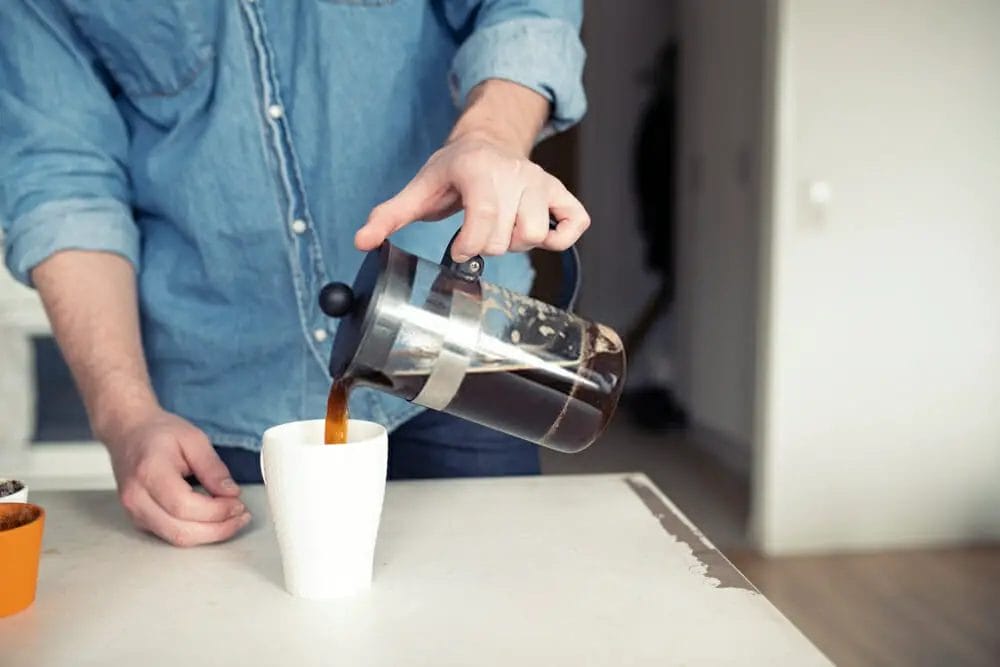
When it comes to finding the perfect grind setting for French press coffee, understanding the micron level is crucial.
Microns refer to the size of the coffee grounds and can greatly affect the flavor and strength of your brew.
For French press brewing, it’s important to achieve a coarse grind with a larger micron size so that the coffee can properly steep and release its full flavor potential.
By paying attention to micron levels and adjusting your grind accordingly, you can take your French press brewing game to the next level.
Explanation of micron measurement and its relevance to grind setting
Understanding the micron measurement of your coffee grind can make or break your morning cup, so it’s crucial to pay attention to the recommended grind setting for French press.
The micron level refers to the size of each coffee particle, which affects how quickly and evenly water flows through during brewing.
A finer grind (smaller particles) will extract more flavor in a shorter amount of time, while a coarser grind (larger particles) will extract less flavor but require a longer brew time.
To achieve the ideal French press extraction, aim for a medium-coarse grind with a range of 800-1000 microns.
This allows enough surface area for flavor extraction without clogging the filter and producing over-extracted or under-extracted coffee.
Check out this table below for a visual representation of appropriate micron levels for different brewing methods:
| Brewing Method | Ideal Micron Level Range |
|---|---|
| Espresso | 200-400 |
| Pour Over | 400-800 |
| French Press | 800-1000 |
| Cold Brew | 1000+ |
By understanding these measurements and adjusting your grinder accordingly, you can elevate your at-home coffee game and enjoy the freedom of customization in every cup.
Emphasizing the focus on achieving a coarse grind for French press brewing
To create a smooth and immersive morning ritual, it’s crucial to imagine the feeling of plunging into a rich and full-bodied cup of coffee that’s been brewed to perfection through a coarse grind.
Here are four tips to emphasize the importance of achieving a coarse grind:
- A finer grind can result in over-extraction, causing bitterness and acidity in your brew.
- A coarser grind allows water to flow more freely through the coffee, resulting in a smoother cup.
- The plunger on your French press requires some resistance for optimal extraction, which is achieved with a coarse grind.
- Coarse grinds also make it easier to separate the grounds from the final product, ensuring you get only pure coffee goodness.
Brewing and Extraction
When adding ground coffee to my French press, I typically use a ratio of 1:15, meaning one part coffee to fifteen parts water. This ensures that the coffee is neither too weak nor too strong.
The recommended extraction time for a French press is approximately four minutes. It’s important not to over or under-extract the coffee as this will affect the flavor development.
During these four minutes, I allow the coffee grounds and hot water to steep together before pressing down on the plunger and enjoying my perfectly brewed cup of coffee.
Adding ground coffee to the French press
Now, you’ll want to scoop the freshly ground coffee into the French press and savor the aroma of rich, flavorful coffee.
To ensure optimal taste and extraction, it’s important to measure out the right amount of coffee for your desired strength.
Here are some tips for adding ground coffee to your French press:
- Use a scale or measuring spoon to accurately measure out your desired amount of coffee (a general rule is 1:15 ratio of coffee to water).
- Add the ground coffee directly into the empty French press before pouring in hot water.
- Gently shake or stir the grounds to ensure they are evenly distributed in the bottom of the carafe.
- Allow the coffee grounds to bloom by pouring just enough hot water to cover them and letting it sit for 30 seconds before adding more water.
- After adding all of your hot water, give the mixture a final gentle stir before placing on the lid and allowing it to steep according to your preferred brew time.
With these simple steps, you can enjoy a delicious cup of French press coffee that perfectly suits your taste preferences.
Recommended extraction time: approximately 4 minutes
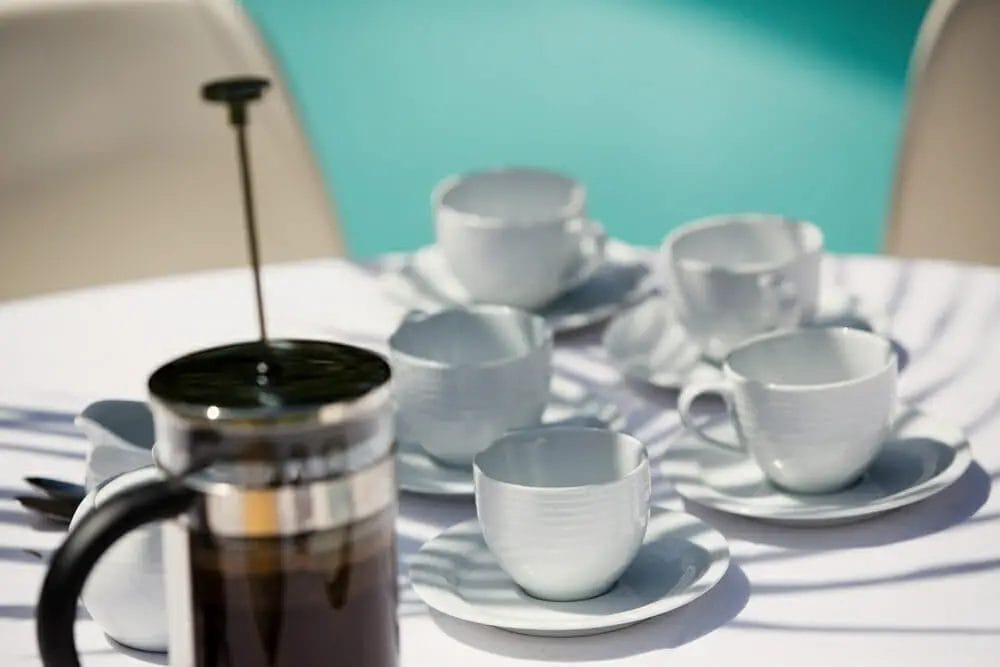
Now that we’ve covered how to add the ground coffee to the French press, let’s talk about the recommended extraction time.
For optimal flavor, it’s suggested that you steep your coffee for around four minutes in a French press.
This allows enough time for the water to extract all of the delicious flavors from the beans without over-extracting and causing bitterness.
To help keep track of time, I recommend using a timer or stopwatch app on your phone.
And remember, while four minutes is a good starting point, feel free to experiment with different extraction times until you find what works best for your taste buds.
After all, isn’t freedom what enjoying a freshly brewed cup of coffee is all about?
Significance of extraction time for flavor development
To get the most out of your morning brew, you’ll want to pay attention to how long you let it steep in the press.
Here are four reasons why extraction time is significant for flavor development:
- A shorter extraction time can result in a weak and underdeveloped taste, while a longer one may create bitterness and over-extraction.
- Extraction time affects the amount of caffeine and acidity present in your coffee. A shorter steeping time will produce a weaker cup with less caffeine and acidity, whereas a longer steeping time will increase both.
- The type of roast used also plays a role in determining an appropriate extraction time. Lighter roasts may require less steeping time than darker ones due to their higher acidity levels.
- Ultimately, the perfect extraction time varies based on personal preference and taste buds; experimenting with different times can help you determine what works best for you.
So don’t be afraid to play around with your brewing process – after all, true freedom lies in having control over your cup of coffee!
Evaluating the flavor of the brewed coffee
When evaluating the flavor of my freshly brewed coffee, I create a list of its key characteristics such as acidity, sweetness, body and finish.
This helps me pinpoint any over-extraction that may result in a bitter taste and adjust the coarseness accordingly.
Similarly, if I notice under-extraction resulting in a weak taste, I make necessary adjustments to the coarseness settings on my grinder.
It’s important to note that small adjustments can make a big difference in achieving the desired flavor profile.
To emphasize this point, I use a table to keep track of my grind size and corresponding flavor notes until I find the perfect balance for my French press brews.
Identifying over-extraction (bitter taste) and adjusting coarseness accordingly
If your coffee tastes bitter, it’s likely that the extraction process has gone too far.
You’ll need to adjust the coarseness of your grind to achieve a smoother flavor.
Over-extraction occurs when water passes through the coffee grounds for too long, resulting in a bitter taste.
To avoid this, start by grinding your beans at a coarse setting and gradually adjust it until you find the sweet spot where your coffee is smooth and flavorful.
Different types of coffee require different coarseness levels, so don’t be afraid to experiment with various settings until you find what works best for you.
Remember that grinding fresh beans is crucial for achieving optimal flavor. Invest in a high-quality grinder and enjoy the freedom of brewing delicious French press coffee at home.
Addressing under-extraction (weak taste) and making necessary coarseness adjustments
Feeling like your morning cup of joe is lacking in flavor and strength? It may be time to adjust the coarseness of your grind to combat under-extraction and achieve a more robust taste.
Here are four steps that can help you achieve this goal:
- Start by adjusting the grind size to be finer, making sure not to go too fine as this could cause over-extraction.
- Increase the amount of coffee used per cup, as a higher ratio of coffee to water will result in a stronger brew.
- Increase the steeping time by an additional minute or two, allowing for more extraction from the beans.
- Finally, consider using hotter water when brewing as hotter water extracts more flavor compounds from the beans than colder water.
By following these steps, you can ensure that your French press coffee is rich in both flavor and strength, satisfying even the most discerning palate.
Emphasizing the importance of small adjustments to achieve the desired flavor
Hey there, I can’t stress enough the importance of small adjustments when it comes to achieving the perfect cup of coffee.
Even minor changes can have a significant impact on the flavor profile of your brew.
Check out this table to get an idea of how adjusting your grind size by just a few microns can make all the difference in extracting the right amount of flavor from your beans.
| Grind Size (Microns) | Extraction | Taste Description |
|---|---|---|
| 1000 | Under-extracted | Weak, possibly sour |
| 1200 | Balanced extraction | Full-bodied, rich, and flavorful |
| 1400 | Over-extracted | Bitter, possibly harsh |
It’s important to note that these measurements aren’t exact and may vary depending on individual preferences and brewing parameters, but it’s a good starting point for making small adjustments until you achieve your desired taste.
Remember, don’t be afraid to experiment and try different settings until you find what works best for you – after all, that’s what true freedom is all about!
Understanding the Steak Analogy
As I’m exploring the concept of adjusting grind settings for coffee brewing, I find myself drawing parallels between cooking a steak and finding the right flavor profile.
Just like different cuts of steak require different cooking times based on their thickness, different types of coffee beans also require specific grind sizes to achieve optimal extraction.
By understanding this analogy, I can better understand how to adjust my grind settings to achieve the desired flavor profile in my French press coffee.
Drawing parallels between cooking a steak and adjusting grind settings
When you’re grinding coffee beans for your French press, think about it like cooking a steak – adjusting the grind settings is just as important as choosing the right cut and seasoning.
Just like how a well-marbled ribeye needs a shorter cooking time than a leaner sirloin, different grind sizes require different brewing times to extract the optimal flavor from the beans.
It’s also crucial to consider the roast level of your coffee and adjust accordingly – darker roasts need coarser grinds while lighter roasts benefit from finer grinds.
And just as you wouldn’t season your steak with salt until after it’s cooked, adding any additives or flavors to your French press brew should be done after brewing to avoid clogging or bitterness.
By paying attention to these nuances and experimenting with different combinations, you’ll find yourself creating perfectly balanced and delicious cups of coffee every time – giving you the freedom to enjoy that perfect cup in peace.
Explaining the concept of different thicknesses requiring different cooking times
Just as the thickness of a steak dictates how long it should be cooked to achieve the desired level of doneness, the grind size of coffee beans influences the extraction time and ultimately the taste of the coffee.
Here’s a more detailed breakdown:
- Rare Steak vs. Coarse Grind: A rare steak is quickly seared on high heat, preserving its tenderness and juicy flavor inside, similar to a coarse grind in coffee brewing. Coarse coffee grounds require less time to extract flavor, preventing over-extraction and bitterness. This is why a coarse grind is recommended for French press brewing, where the water and coffee are in contact for a longer time.
- Medium Steak vs. Medium Grind: A medium steak is cooked longer than a rare steak, allowing heat to penetrate deeper into the meat. Similarly, a medium grind has a more balanced extraction rate, suitable for methods like drip or pour-over brewing. The extraction is slow enough to prevent bitterness, yet fast enough to extract a full range of flavors.
- Well-done Steak vs. Fine Grind: A well-done steak is cooked for the longest time, letting the heat go all the way through the meat. A fine grind, like what you might use for an espresso, has a faster extraction rate. The water quickly extracts flavors from the small coffee particles, leading to a robust and intense flavor. However, over-extraction can lead to bitterness, hence precise timing is crucial in brewing with a fine grind.
Applying the analogy to coffee brewing and finding the right flavor profile
If you want to find the right flavor profile for your coffee, you’ll need to experiment with different brewing methods and ratios of water to grounds.
When it comes to french press, the grind size plays a crucial role in determining the taste of your coffee.
Just like how thicker cuts of meat require longer cooking times, coarser grinds will need longer steeping times while finer grinds will require less time.
This is because the surface area of the coffee grounds affects how quickly they release their flavors into the water.
Finding the perfect balance between grind size and steeping time will result in a rich and flavorful cup of coffee that satisfies your taste buds.
So don’t be afraid to play around with different grind sizes until you find that sweet spot – it’s all part of the fun and freedom that comes with brewing your own coffee!
Conclusion
So there you have it, my fellow coffee enthusiasts! Grinding coffee beans for French press is a delicate art that requires attention to detail.
The importance of grind setting can’t be overstated – it can make or break the taste of your brew.
But don’t fret, with some patience and practice, finding the right grind setting becomes second nature.
Remember to pay attention to the micron level – a coarser grind will produce a weaker cup of coffee while a finer grind will result in bolder flavors.
Don’t be afraid to experiment with different settings until you find what works best for you.
And once you’ve found your sweet spot, be sure to adjust based on taste preferences and brewing conditions.
Lastly, I like to think of grinding coffee beans for French press as similar to cooking steak – both require careful monitoring of temperature and timing.
Just as overcooking a steak can ruin its flavor, over-extracting your coffee grounds can result in bitter brews.
So take your time and enjoy the process – after all, there’s nothing quite like savoring a delicious cup of freshly brewed French press coffee.

